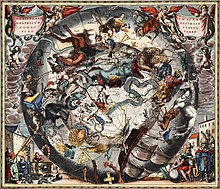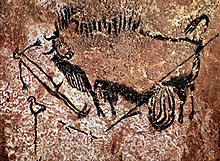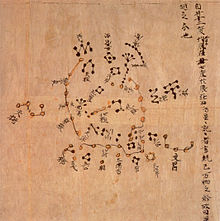Constellation


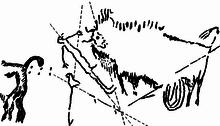

In today's astronomy, a constellation is understood to be a region of the starry sky that is delimited from other regions of the sky in relation to a star train of freely visible bright stars ( pattern recognition ). For the view of the sky from the earth, in spherical astronomy at the beginning of the 20th century with international agreement the boundaries of 88 constellations were established, with which the area of the celestial sphere is completely divided up so that celestial bodies can be easily assigned.
With the naked eye, without tools, with a few exceptions - like the Andromeda Nebula - only stars that belong to our galaxy, the Milky Way , can be seen in the starry sky . Bright stars were used for visual orientation as early as the Neolithic Age, grouped into groups of stars and seen as figures, interpreted mythologically in early antiquity and assigned to mythical figures, animals or objects since antiquity. A well-known example is the so-called Big Bear (Ursa maior) or part of it as the Big Dipper , whose two box stars show the direction to the North Star.
The stars of such a constellation or a constellation have relatively small angular distances from one another when viewed from the earth and are therefore relatively close to one another in the sense of the celestial coordinates of spherical astronomy. However, this neighborhood is only an apparent one. By measuring their parallax , the distance from the solar system can be determined for individual stars ; it can differ many times over for the stars in a constellation (see, for example, Orion's star list ). Thus, stars can have a greater distance to other stars in the same constellation than to the sun. On the other hand, two stars of different constellations can actually be at a smaller distance from each other than apparently closely spaced stars of the same constellation.
In many cultures, constellations were an important means of orientation and especially important for seafaring. Today, they are clearly defined for mapping the sky and the localization of objects. The International Astronomical Union (IAU) has defined the constellation boundaries according to celestial coordinates and uses them among other things. a. for the approximate location of variable celestial objects such as meteors or novae . Star trains are also referred to as constellations , star constellations that are not precisely defined as asterism . This term also includes the historical constellations of western astronomical history and the constellations of other cultures.
Constellations can be found in almost all cultures and can be traced back to the early advanced cultures . Human-like figures (such as Orion), triangles to hexagons and longer rows of stars (such as Andromeda, five- star row , water snake) or star trains (dragon, snake, Eridanus) play a special role. Today's constellations go back to twelve Babylonian and ancient Egyptian zodiac signs , which were expanded to 48 in ancient Greece . More were introduced between 1600 and 1800. Since 1922, 88 constellations have been used internationally recognized, the boundaries of which were officially defined by the IAU in 1928 after preliminary work by Eugène Delporte .
The Astrognosie is the field of astronomy that deals with constellations and star trains. The names of the constellations are important for the systematic naming of stars with Greek letters ( alpha , beta , gamma , ... ) and the Latin name of the constellation, e.g. B. Alpha Centauri .
Definition of the constellation constellation - asterism


As asterism (from Latin astrum from Greek ἄστρον astron "constellation, star, star") is a group of (mostly bright) stars that - linked with imaginary connecting lines (" star trains ") - a conspicuous shape or figure in astronomy Heaven forms. An asterism can be part of a constellation and consist of neighboring stars (examples are the "Big Dipper" as part of the constellation Great Bear or the "belt" of Orion); but it can also include conspicuous stars from different constellations, such as the summer triangle or the winter hexagon , the stars of which are distributed over a large part of the sky. Characteristic of an asterism is its conspicuousness, therefore faint, inconspicuous constellations are not asterisms. Occasionally, however, historical constellations that were previously recorded on star maps, such as. B. the constellation " Schiff Argo ", referred to as asterisms.
In addition, in the mapping systems of other cultures, for example in ancient Indian or Chinese astronomy or that of the Mayans, there are constellations in which completely different figures are recognized.
Meaning of the constellations
Constellations are only presented subjectively to the observer . The impression that the stars of a constellation are close to one another in the sky is based on the projection effect .
The twelve signs of the zodiac , which go back to the Babylonian constellations of the ecliptic , form one of the foundations of astrology . Since the constellations have since shifted by about 30 degrees due to the precession against the signs of the zodiac, they no longer match, however, and Western astrology generally rejects the interpretation related to actual constellations (sidereal astrology) ( zodiac ).
Constellations and asterisms also appear in Greek didactic poems on the course of the year and agriculture, where they are used to classify the seasons .
In astronomy , constellations in star catalogs have been used to indicate positions since ancient times . Around 1800, star catalogs still divided the celestial objects into the constellations, but soon afterwards one switched to a pure position specification with right ascension and declination . But the astronomical nomenclature of the visible stars in the Bayer / Flamsteed code of 1603 and 1712, apart from their trivial names, is still based on this system of areas of the starry sky , such as Alpha Centauri after the constellation of the centaur.
Despite their relatively little importance today, constellations have lost none of their fascination for the observer of a dark starry sky and play an important role in the popularization of astronomy. She uses the didactics of astronomy - in connection with the associated star sagas - to get young people enthusiastic about "astronomy" and to introduce them to modern astronomy on the basis of historical developments.
Origin of the constellations
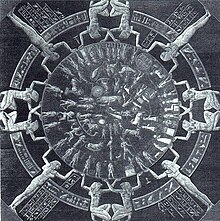
Constellations probably already existed in prehistoric times. In any case, constellations are known of most of the cultures that could still be anthropologically examined in a pre-Iron Age and writtenless stage, such as the constellations of the North American Indians, the Aborigines and the San in southern Africa. How far back the first constellations go back into European early history is unknown, but it is possible that a complete zodiac is already depicted in the bull hall of the Lascaux cave . [Source?] The identification of a group of points above the aurochs as the Pleiades seems likely, since both the position relative to the aurochs ( bull ) and the relative positions of the six points to each other correspond to those of the Pleiades. However, this requires the implicit assumption to identify a constellation in the aurochs. In ancient Egyptian tombs there are also isolated constellations, for example in the tomb of Seti I ( KV17 ). The images depicted in the temple of Dendera in the first century BC show the Egyptian already together with the Babylonian zodiac.
Ancient constellations
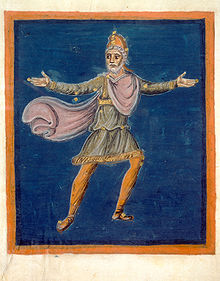
The first secured today's constellations, especially those also used in astrology zodiac signs , go to the ancient Egyptians and Babylonians back. The first of these constellations of the zodiac appeared as early as the third millennium BC. Chr. On. A first complete zodiac was created around 410 BC. The present-day signs of the zodiac roughly coincided with the corresponding constellations about 2100 years ago, but have shifted against them in the course of precession . Of a thirteenth constellation cut by the ecliptic , Serpent Bearer , only one foot protrudes above the ecliptic.
With his cadastre , Eratosthenes described the causal formation of 44 constellations, a few centuries later Ptolemy described 48 constellations. The constellations are mainly named after figures, people and objects from Greek mythology . Both are thus in a literary tradition, which was mainly passed down into the Middle Ages through the didactic poems Phainomena (celestial phenomena) by Aratos by Soloi and the poeticon Astronomicon by Hyginus . The Ptolemaic star catalog of the Almagest , in which the stars belonging to the images are listed, is initially only known in the Arab world and has been distributed to the Latin world since the 12th century through translations from Greek and Arabic. Many of the star names used today go back to Arabic scholars , but no new constellations. The Islamic world took over these from antiquity, older pre-Islamic constellations are disappearing and are only partially passed down as images, for example al-Sufi depicts Cassiopeia together with the Bedouin constellation camel.
Today's constellation Haar der Berenike was known as asterism in antiquity , but was not considered a separate constellation, but part of Leo . The "throne of Caesar ", which was placed in the sky by Augustus , was no longer used after antiquity. The traditional constellation Antinous, on the other hand, which the Roman emperor Hadrian introduced in honor of his favorite who died in the Nile (according to legend, Antinous sacrifices himself to prolong Hadrian's life), was initially considered asterism and part of the eagle and only became a part of modern times listed as a separate constellation. However, it is no longer used today. Since Antinous was depicted in the claws of the eagle, the constellation was also occasionally seen as Ganymede , whose myth such a depiction fits.
Modern extensions
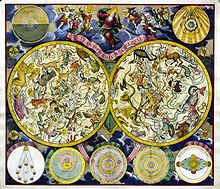
In modern times, further constellations were first introduced in the southern sky , which was unknown to Europeans in ancient times. In the Uranometria of 1603, Johann Bayer took over some constellations from Petrus Plancius ' celestial globes , which in turn was the first to depict them on his celestial globes according to descriptions by the Dutch sea navigators Pieter Dirkszoon Keyser and Frederick de Houtman . Often, however, Bayer is named as the person who introduced these constellations, presumably because his uranometria was much more widespread. However, Bayer only adopts thirteen of the Plancius constellations, omitting the cross. The now known constellations Giraffe and Unicorn were not published until 1612 (also by Plancius).
These three constellations appear, together with others by Plancius, which are no longer used today, by Jacob Bartsch in 1624, some of which are finally taken over by Johannes Hevelius in his atlas Firmamentum Sobiescianium , published in 1687 , which defines further images. In ignorance of Plancius' work, the giraffe, cross and unicorn are occasionally ascribed to Hevelius, Bartsch or the otherwise little-known astronomer Augustin Royer . Hevelius dedicated his star atlas to his king, Jan III. Sobieski , and placed the heraldic shield of his house as a constellation shield in the summer sky. The frontispiece shows Hevelius with the new constellation, in front of the muse Urania in a circle of famous astronomers. Around 1750, after an observation trip to the Cape of Good Hope in South Africa, Nicolas Louis de Lacaille expanded the constellations of the southern sky to include mostly thematic constellations that were supposed to symbolize technical progress, such as the chemical furnace or the air pump . In addition to twelve new constellations, the division of the "ship Argo" into the ship's sails (Vela), aft deck (Puppis) and keel (Carina) can be traced back to him . In this area of the sky, Lacaille also introduced another nautical constellation, the compass .
Constellations no longer used
Julius Schiller tried in 1627 by publishing a Christianized star atlas, the Coelum Stellatum Christianum , to replace the pagan constellations with figures from the Bible and saints, using Bayer's catalog coordinates and improving and expanding them in collaboration with Bayer. The zodiac images, for example, became the apostles . The attempt was not very well received, but at least the Schiller constellations were depicted on two plates by Andreas Cellarius in his artistic masterpiece Harmonia Macrocosmica , together of course with the conventional constellations on other plates. Bayer had left out the only originally Christian constellations, the cross and the unicorn, to which Schiller referred, when adapting Plancius. Jakob Bartsch undertook a less radical attempt at Christianization , who in 1624 made biblical references to the existing constellations in his book Usus Astronomicus .
Hevelius' example with the shield was followed by numerous court astronomers over the next 150 years and placed insignia of their respective rulers in the sky. The more well-known constellations that have appeared in sky atlases include the Brandenburg Scepter or the Royal Bull of Poniatowski , while others, except in the original dedication documents, never appeared in a star map and were mainly used to promote the career of the respective court astronomer. The constellation Schild itself is the only one of these political images that is still recognized today.
In 1754, John Hill proposed, presumably with satirical intent in view of the numerous contemporary expansions, 13 further constellations which, according to the sense of time, were dedicated to lower creatures, for example the toad, the earthworm, or the spider. The joke went unnoticed in the professional world. In 1789, after the discovery of Uranus , Maximilian Hell set a monument to the discoverer by introducing two new constellations, the large and small Herschel telescope , of which only the large one, between Gemini and Auriga , was longer on the star maps. Constellations were sometimes introduced without political, scientific or even special motivation. Thus founded Jérôme de Lalande the 1799 he introduced the constellation Felis with "I love these animals very [...] The starry sky has given me enough work, now I can have a joke with it." But he had no doubt as ulterior motives, so To refute Voltaire , who did not like cats and had blasphemed during his lifetime that the cat was not one of the many animal constellations.
Since more and more stars and nebulae have been found and cataloged since the invention of the telescope , these new constellations were needed to maintain an overview, especially since the ancient constellations are parts of the sky that appear unspectacular (but not starless) to the naked eye , just leave it out. However, the number of known objects increased so much that too many of these extensions proved impractical, and so the later ones disappeared again. A first step towards the standardization and general recognition of the constellations was taken at the first European astronomers' congress in 1798, at which many of the constellations proposed in the previous years were rejected and others were suggested. In a star atlas from 1801 by Johann Elert Bode , who took part in the congress, a total of 99 constellations are entered, such as the “hot air balloon”, the “printer's workshop”, the “ northern fly ” or the “ cat ”.
Even after the constellations were determined in 1928, there were occasional suggestions for renaming stars and constellations. The best known is probably the book "A better sky" by Alan Patrick Herbert, published in Great Britain in 1944, in which the latter suggests renaming the constellations and almost 300 stars to more contemporary names, as these are more accessible to people. From Orion should be, for example, "The Sailor" and its stars by sailors such as James Cook be renamed. Five stars in Draco , renamed "The Tyrants", were to bear the names of Attila , Hitler , Mussolini , Robespierre and Kublai Khan .
Today's constellations
In 1922 Henry Norris Russell proposed a list of three-letter abbreviations for 89 constellations, listing both the "ship Argo" and its parts. Russell's reasons for his selection have not been passed down, but he probably limited himself to the pictures of which star names were listed in the Harvard Revised Catalog , a standard work of the time. At the first general assembly of the International Astronomical Union (IAU) in Rome, Russell proposed the list to other astronomers who received it positively, and it became increasingly common. Independently proposed two- and four-letter abbreviations, however, did not prevail. The constellations are still abbreviated today by the three letters suggested by Russell, e.g. B. with the designation of stars: The main star in the swan (Cygnus), α Cygni is abbreviated α Cyg.
Establishing the limits
At the first general assembly in 1922, the number of constellations was set at 88. At the second in Cambridge in 1925 , the Belgian astronomer Eugène Delporte was commissioned to define the exact boundaries of these constellations so that each celestial coordinate could be clearly assigned to a constellation. Delporte defined the boundaries according to the coordinate circles of the epoch of January 1, 1875. Adjacent points of the resulting lines had either the same declination or the same right ascension. To this end, he was able to build on the preparatory work by Benjamin Gould , who, after surveying the southern sky in his work Uranometria Argentina , had staked out the constellations around the south celestial pole according to the coordinates of 1875. At the third general assembly in Leiden in 1928 , the exact limits were approved by the IAU and finally set. Delporte's work went to press in 1930 (see literature). So that the assignment of objects to the constellations does not change due to precession , the coordinates of the boundaries must be calculated for each epoch and no longer run exactly on coordinate circles. As a result, boundary points between the corners have to be interpolated today.
Changes
The huge constellation ship Argo, named after the ship of the Argonauts saga , was finally divided into Vela (the sail), Puppis (the aft deck) and Carina (the keel) and removed from the list of constellations. These three constellations therefore only have a single set of Bayer star names: There is, for example, α Car, namely Kanopus , but no α Pup or α Vel. Similarly, the Greek letters also jump back and forth between the two unrelated parts of Serpens (Serpentis caput and Serpentis cauda). The stars γ Aur and δ Peg do not exist at all or are now called β Tau and α And. They used to have both designations next to each other, but this is no longer permitted today in the interests of clarity.
Geometric properties
A simple geometric figure of the constellation borders like a ( spherical ) square occurs almost only in the south, and here nine times, while a tenth is on the equator (constellation Sextans ). Most of the delimiting polylines have a significantly higher number of corners and sides. The extreme represents a polygon defined for the delimitation of the constellation Draco (dragon) with no fewer than 50 corners or sides. The largest area of a spherical polygon has the constellation Hydra with 1302.84 square degrees , followed by Virgo , Ursa Maior , Cetus and Hercules (all over 1200 square degrees). The largest southern constellation is Centaurus , followed by Sagittarius and Puppis . In relation to the total of all 88 constellations, Phoenix (469.32 square degrees) is closest to the average area of 468.8 square degrees (the full solid angle of the celestial sphere is just under 41,253 square degrees). The smallest is Crux (68.45 square degrees) and then Equuleus (71.64 square degrees). The extremes of size of Crux and Hydra are also reflected in the extreme number of neighbors. Crux only has 2, while Hydra has 12 real neighbors and one fake neighbor that is touched at one point. There are only 4 such false points of contact, one of them in the northern sky (near α Lyncis ).
In the past, the constellations were classified according to their relation to the ecliptic , so there were the ecliptic constellations and the constellations north of the ecliptic and the southern constellations. This classification can be found until the middle of the 20th century. It was initially determined by tradition, later by the need to separately and thoroughly catalog the area along the ecliptic for asteroid search. Meanwhile, this classification is no longer in use and when Northern Constellations those are now north of the celestial equator called.
Asterisms and constellations from other cultures
All cultures know asterisms. The most famous asterism in the western world is the big dipper, the stars of which make up part of the Great Bear . In some western cultures the same constellation is named differently, for example Big Dipper ("big spoon") in the USA. Well-known asterisms are also the summer triangle and the winter hexagon . The most famous worldwide and for millennia is the star cluster of the Pleiades , whose understanding as an independent group can be proven in almost every culture. Asterisms can turn into constellations over time, as happened with Berenike's hair .
The ancient Egyptians divided the sky less according to constellations, few are known, and these do not correspond to the modern western ones. In China , a different tradition was followed, the Chinese star constellations are smaller than the western ones, the ecliptic alone is divided by the Chinese tradition into 28 ù , Xiù - "residences", corresponding to the distance the moon travels per day. There are similar 28-segment divisions in India and in the Islamic world, but they are not associated with figurative representations like the constellations. The representation in Chinese star maps is also not figurative for the other constellations known there, but, as in the more modern western star maps, by stars connected with lines. In addition to astronomical star maps, star maps used for sea navigation have also been preserved in this tradition.
For the Aztecs , the constellation of the fire drill played a major role in a renewal ceremony that takes place every 52 years. Which stars formed this is controversial today. Few of the Aztec constellations are known, and only a few of them can be located in the sky.
The pre-Islamic Bedouin constellations of Arabia are also only known in exceptional cases and localized in the sky.
Scriptless cultures
The Australian Aborigines and the San (Bushmen) in southern Africa know other images besides the images formed by stars. The dark clouds of dust in front of the band of the Milky Way are recognized by the Aborigines as emu , by the San as an ostrich , with the coal sack as the head and the dust bands in front of the Milky Way in Sagittarius as the body. These are the largest "star" images in the sky. In addition, at least the Aborigines know other dark star images.
The Pacific peoples named only a few stars and constellations. In addition to the Pleiades , whose visibility in the eastern evening sky marks the beginning of the year, things from the everyday environment and marine life are immortalized as constellations. While some constellations are congruent with the western ones, the boundaries of most are different.
The inhabitants of the island of Manus north of Papua New Guinea are still familiar with the following pictures, among others: The belt stars of Orion are canoeists, the southern crown is a net, the Eridanus river is a fishing net. A huge constellation is the bird with the stars Sirius , Canopus and Prokyon . The marine animals include the crab ( northern crown ), and as fish the shark (parts of the Sagittarius and the scorpion ), the stingray (the part of the scorpion with the claws) and other fish species, for example in the dolphin or in some stars of the Circles are seen. There are no legends associated with the constellations, but rather short stories that can be summed up in a few words. Especially the fish constellations play an interesting role. In the main fishing season none of them are in the sky, only when the fishing is not worthwhile. The constellations in the sky symbolize the absence of fish in the sea. The beginning of the monsoon is also associated with the then rising constellation of the bird. Unlike other cultures, the Manus did not use the constellations for navigation because, according to their statement, "any star can be used, because they all move the same".
See also
- Zodiac signs
- List of constellations
- History of astronomy
- List of constellations in different languages
- Planet children
literature
chronologically. Newest first.
- Zorica Prnjat, Milutin Tadić: Asterism and constellation: Terminological dilemmas. In: Journal of the Geographical Institute “Jovan Cvijić” SASA. Volume 67, No. 1, 2017, pp. 1-10, doi: 10.2298 / IJGI1701001P .
- Ulf von Rauchhaupt : In the stars. The 88 constellations in portrait. Fischer Taschenbuch Verlag, Frankfurt am Main; 2013. ISBN 978-3-596-19653-1 .
- Eratosthenes: star tales. Edited by Jordi Pàmias and Klaus Geus . Utopica, Oberhaid, 2007 (for reception see Eratosthenes ), ISBN 978-3-938083-05-5 .
- Eckhard Slawik , Uwe Reichert : Atlas of the constellations. Spektrum Akademischer Verlag, Heidelberg 2004, ISBN 3-8274-0268-9 .
- Ian Ridpath : The Great Constellations. Patmos, Düsseldorf 2004, ISBN 3-491-69112-5 ( The English edition “Star Tales” online ).
- Richard Hinckley Allen : Star Names - Their Lore and Meaning. Dover Publications Inc., New York 1963, ISBN 0-486-21079-0 .
- Eugène Delporte : Délimitation scientifique des constellation, tables et cartes. IAU, Ath the University Press, Cambridge 1930.
- Anton Hauber : Planetary images and constellations. On the history of human belief and error. Strasbourg 1916 (= studies on German art history. Volume 194).
Web links
- Photographs of the constellations
- Limits in the sky - Article by Christian Pinter in Wiener Zeitung
- Catalog data of the boundaries of the constellations
- Julius Schiller: Coelum Stellatum Christianum (Christian starry sky) from 1627 at: Linda Hall Library.
Individual evidence
- ↑ http://www.ianridpath.com/iaulist1.htm
- ↑ http://www.iau.org/public/constellations/
- ↑ See entry Asterism in COSMOS - The SAO Encyclopedia of Astronomy .
- ↑ For the distinction between star constellation and asterism, see also Z. Prnjat, M. Tadić: Asterism and constellation: Terminological dilemmas.
- ^ Andreas Cellarius: Harmonia Macrocosmica Sev Atlas Universalis Et Novus. Totius Universi Creati Cosmographiam Generalem, Et Novam Exhibens. ( Memento of August 14, 2011 in the Internet Archive ) Amsterdam 1661, pp. 161–168 (Coeli Stellati Christiani Hemisphaerium prius), pp. 169–185 (Coeli Stellati Christiani Hemisphaerium posterius), star maps between pp. 160/161, 168 / 169.
- ↑ Constellations and zodiac signs in the Astrodicticum simplex by Florian Freistetter on ScienceBlogs (including star map on page 2)
